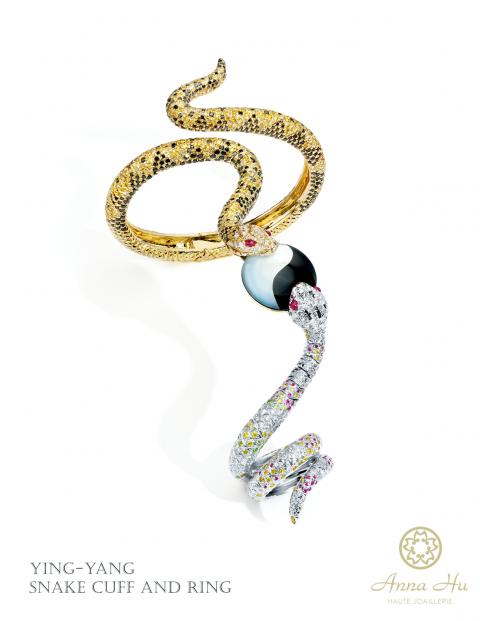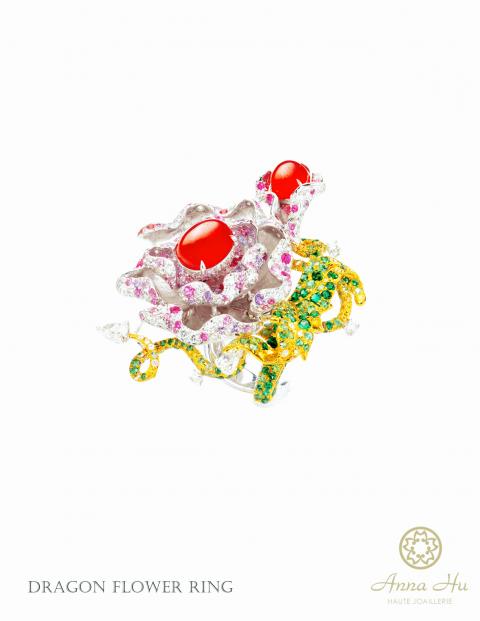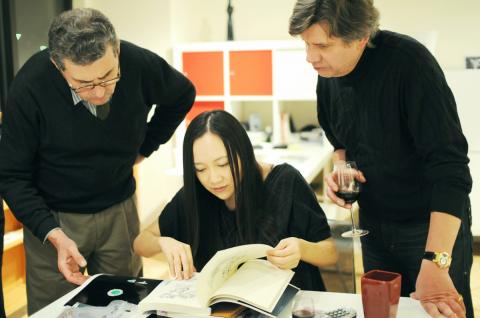Anna Hu (胡茵菲) had her heart set on a career as a cellist until a shoulder injury cut short her musical aspirations. Now the 34-year-old shines as a jeweler whose luxurious, art-inspired designs have attracted clients ranging from Cindy Sherman to Madonna. Her creations also make regular appearances on the red carpet, including February’s Academy Awards, where Scarlett Johansson and Hilary Swank wore pieces that paid homage to Surrealist paintings.
Though she launched New York City-based Anna Hu Haute Joaillerie just four years ago, Hu has already garnered high praise among jewelry connoisseurs and collectors. In a Wall Street Journal profile, David Warren, the director of Christie’s in London and the Middle East, said Hu is considered among the top five or six contemporary jewelry designers in the world.
Born in Taiwan, Hu immigrated to the US with her family when she was a teenager. Though both her parents worked in the jewelry trade, Hu’s first passion was classical music.

Photos courtesy of Anna Hu Haute Joaillerie
“Before I hurt my shoulder, my whole life was about the cello,” says Hu, who practiced at least five hours a day before developing tendinitis. Her chiropractor ordered her to reduce her playing time to half an hour.
With her musical career on hold, Hu felt “very empty.”
“It was in 1997, right around my birthday in March, and for two months it was like hell for me,” she says.

Photo Courtesy of Anna Hu Haute Joaillerie
Then her father, a diamond dealer, suggested that she take a jewelry design class to help lift her out of her depression.
“It was like a transformation for me,” Hu says. “I learned that it doesn’t matter if it’s performing arts or visual arts, it’s all universal.”
Hu, who earned master’s degrees in art history and art administration from the Parsons School of Design and Columbia University, now applies the same perfectionist tendencies to her jewelry that she did to the cello. She cites artists Vincent van Gogh, Gustav Klimt and Chang Dai-chien (張大千) as inspirations; her favorite jeweler is Rene Lalique.

Photo Courtesy of Anna Hu Haute Joaillerie
Despite her celebrity clientele, Hu lays down the law for her custom work and insists on creating pieces that reflect her aesthetic point of view.
“I don’t care if someone is rich or whatever their status is, I don’t give a damn,” Hu says. “They come to me, they listen to me.”
She compares the process of designing a piece of jewelry to composing a symphony.

Photo Courtesy of Anna Hu Haute Joaillerie
“Every gemstone is like a musical note. The contours, the shapes, the lines, are like the melody,” Hu says. “The setting technique, the wax modeling and the construction of the jewelry is really like musical theory, it’s like the rhythm.”
Hu listens to the same pieces of classical music over and over again while working. Johann Sebastian Bach’s concertos are “very symmetrical, very structured, with a lot of symmetry” and inspire her when she creates art deco designs.
Frederic Chopin was her composer of choice while making the bold, lushly detailed jewelry Johansson and Swank wore to the Oscars.
“I related them to Chopin, because they are ultra-romantic and very passionate, with organic curvilinear lines,” Hu says.
Crafted by jewelers in New York City and Paris, Hu’s pieces can take years from conception to the final product. One of Hu’s newest showcase creations, a dramatic collar set with hundreds of precious stones in delicate shades inspired by the artwork of Claude Monet, hails back to a trip Hu made to Giverny, France, when she was 21 years old.
Afterward, she visited the Musee d’Orsay and the Museum of Modern Art in New York City to study Monet’s water lily paintings. While working on the necklace, Hu only listened to works by Impressionist composers Maurice Ravel and Claude Debussy.
The setting of the Monet Water Lily Necklace, which includes various gems in a spectrum of soft, watercolor-like colors offset by glittering diamonds of varying sizes, took more than two years to finish.
Hu began with a sketch before picking different jewels for the piece, treating the precious stones like pigment as she laid them out in a wax model.
When Hu showed the stunningly extravagant final creation to her father, who supplies all her jewels, his jaw dropped.
“We bought all these amazing gemstones and he said, ‘I think you can do about a hundred pieces with them,’” Hu says. “He was expecting a hundred different designs and I put them all into one.”
She has already decided that she will make 999 one-of-a-kind pieces before she retires (the Mandarin pronunciation of nine is a homophone for “longevity”) and organize a solo exhibition of her jewelry every five years. She figures that her plan will keep her busy until she is 75 years old.
“It’s all connected, from music to painting to jewelry. It makes sense to me,” Hu says. “I just feel like I am in another world.”
For more information: www.anna-hu.com

Many people noticed the flood of pro-China propaganda across a number of venues in recent weeks that looks like a coordinated assault on US Taiwan policy. It does look like an effort intended to influence the US before the meeting between US President Donald Trump and Chinese dictator Xi Jinping (習近平) over the weekend. Jennifer Kavanagh’s piece in the New York Times in September appears to be the opening strike of the current campaign. She followed up last week in the Lowy Interpreter, blaming the US for causing the PRC to escalate in the Philippines and Taiwan, saying that as

US President Donald Trump may have hoped for an impromptu talk with his old friend Kim Jong-un during a recent trip to Asia, but analysts say the increasingly emboldened North Korean despot had few good reasons to join the photo-op. Trump sent repeated overtures to Kim during his barnstorming tour of Asia, saying he was “100 percent” open to a meeting and even bucking decades of US policy by conceding that North Korea was “sort of a nuclear power.” But Pyongyang kept mum on the invitation, instead firing off missiles and sending its foreign minister to Russia and Belarus, with whom it

The Chinese Communist Party (CCP) has a dystopian, radical and dangerous conception of itself. Few are aware of this very fundamental difference between how they view power and how the rest of the world does. Even those of us who have lived in China sometimes fall back into the trap of viewing it through the lens of the power relationships common throughout the rest of the world, instead of understanding the CCP as it conceives of itself. Broadly speaking, the concepts of the people, race, culture, civilization, nation, government and religion are separate, though often overlapping and intertwined. A government

Nov. 3 to Nov. 9 In 1925, 18-year-old Huang Chin-chuan (黃金川) penned the following words: “When will the day of women’s equal rights arrive, so that my talents won’t drift away in the eastern stream?” These were the closing lines to her poem “Female Student” (女學生), which expressed her unwillingness to be confined to traditional female roles and her desire to study and explore the world. Born to a wealthy family on Nov. 5, 1907, Huang was able to study in Japan — a rare privilege for women in her time — and even made a name for herself in the